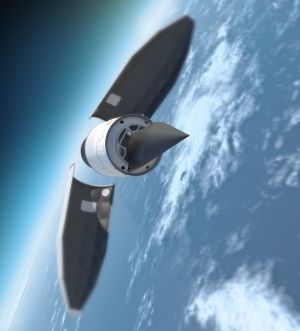
Publisher:
Bonnie King
CONTACT:
Newsroom@Salem-news.com
Advertising:
Adsales@Salem-news.com

~Truth~
~Justice~
~Peace~
TJP
Aug-11-2011 13:39

 TweetFollow @OregonNews
TweetFollow @OregonNews
HTV-2 Collects Unique Data During Several Phases of Second Flight
Salem-News.comThree technical challenges exist within this HTV-2 flight regime. They are categorized as aerodynamic; aerothermal; and guidance, navigation and control.
 Courtesy: darpa.mil |
(WASHINGTON D.C.) - Today, DARPA attempted to fly the fastest aircraft ever built. The Agency’s Falcon Hypersonic Technology Vehicle 2 (HTV-2) is designed to fly anywhere in the world in less than 60 minutes.
This capability requires an aircraft that can fly at 13,000 mph, while experiencing temperatures in excess of 3500F. The second test flight began with launch at 0745 Pacific Time. The Minotaur IV vehicle successfully inserted the aircraft into the desired trajectory.
Separation of the vehicle was confirmed by rocket cam and the aircraft transitioned to Mach 20 aerodynamic flight. This transition represents a critical knowledge and control point in maneuvering atmospheric hypersonic flight. More than nine minutes of data was collected before an anomaly caused loss of signal. Initial indications are that the aircraft impacted the Pacific Ocean along the planned flight path.
“Here’s what we know,” said Air Force Maj. Chris Schulz, DARPA HTV-2 program manager and PhD in aerospace engineering. “We know how to boost the aircraft to near space. We know how to insert the aircraft into atmospheric hypersonic flight. We do not yet know how to achieve the desired control during the aerodynamic phase of flight.
It’s vexing; I’m confident there is a solution. We have to find it.”
* “Prior to flight, the technical team completed the most sophisticated simulations and extensive wind tunnel tests possible. But these ground tests have not yielded the necessary knowledge. Filling the gaps in our understanding of hypersonic flight in this demanding regime requires that we be willing to fly,” said DARPA Director Regina Dugan. “In the April 2010 test, we obtained four times the amount of data previously available at these speeds. Today more than 20 air, land, sea and space data collection systems were operational. We’ll learn. We’ll try again. That’s what it takes.”
According to Schulz, three technical challenges exist within this HTV-2 flight regime. They are categorized as aerodynamic; aerothermal; and guidance, navigation and control. And each phase of flight introduces unique obstacles within these areas.
“To address these obstacles, DARPA has assembled a team of experts that will analyze the flight data collected during today’s test flight, expanding our technical understanding of this incredibly harsh flight regime,” explained Schulz. “As today’s flight indicates, high-Mach flight in the atmosphere is virtually uncharted territory.”
In the coming weeks, the assembled independent Engineering Review Board will review and analyze the data collected. This data will inform policy, acquisition and operational decisions for future Conventional Prompt Global Strike programs—the goal of which, ultimately, is to have the capability to reach anywhere in the world in less than one hour.
Source: darpa.mil
 |
 |
Articles for August 10, 2011 | Articles for August 11, 2011 | Articles for August 12, 2011
Quick Links
DINING
Willamette UniversityGoudy Commons Cafe
Dine on the Queen
Willamette Queen Sternwheeler
MUST SEE SALEM
Oregon Capitol ToursCapitol History Gateway
Willamette River Ride
Willamette Queen Sternwheeler
Historic Home Tours:
Deepwood Museum
The Bush House
Gaiety Hollow Garden
AUCTIONS - APPRAISALS
Auction Masters & AppraisalsCONSTRUCTION SERVICES
Roofing and ContractingSheridan, Ore.
ONLINE SHOPPING
Special Occasion DressesAdvertise with Salem-News
Contact:AdSales@Salem-News.com

googlec507860f6901db00.html



Terms of Service | Privacy Policy
All comments and messages are approved by people and self promotional links or unacceptable comments are denied.
[Return to Top]
©2025 Salem-News.com. All opinions expressed in this article are those of the author and do not necessarily reflect those of Salem-News.com.